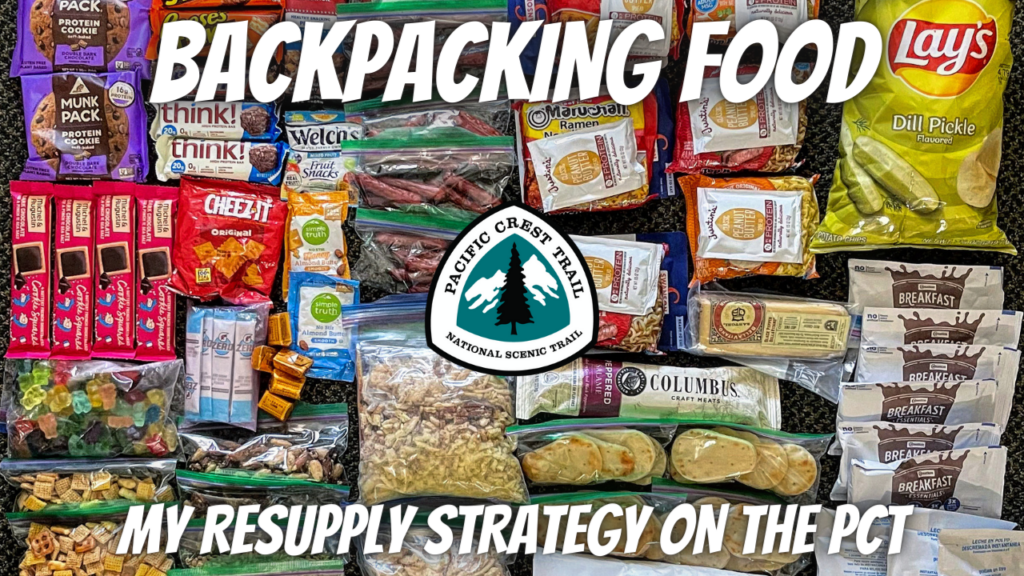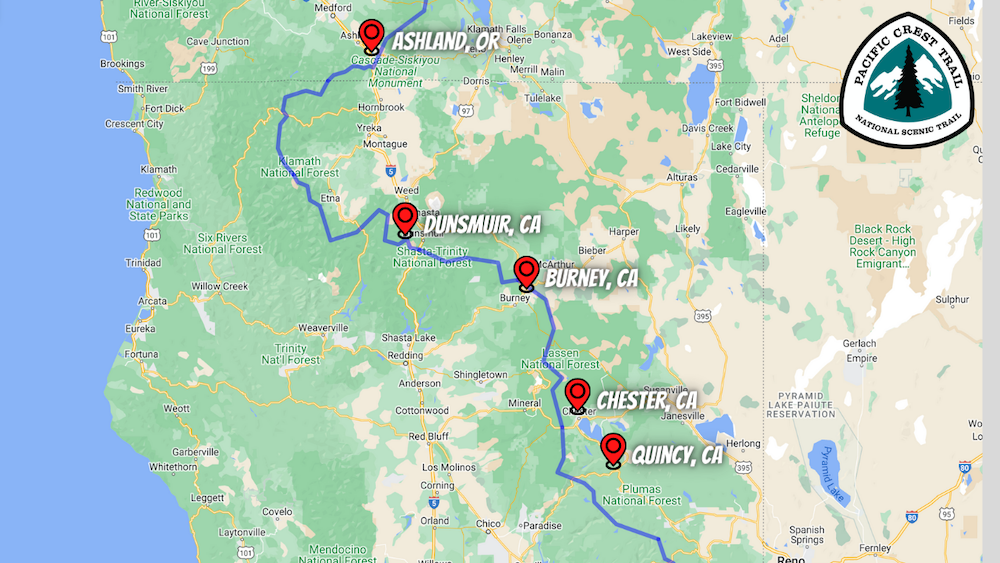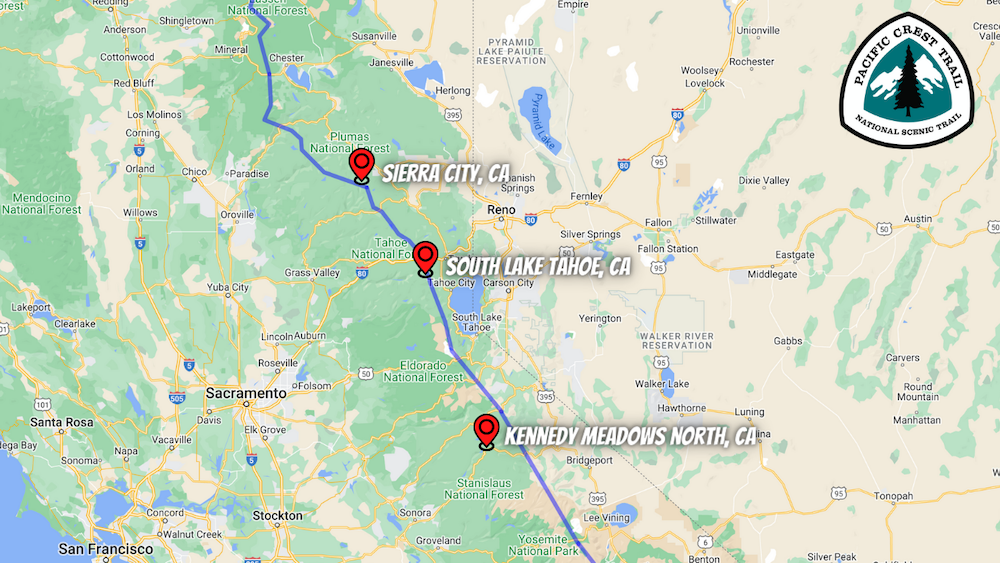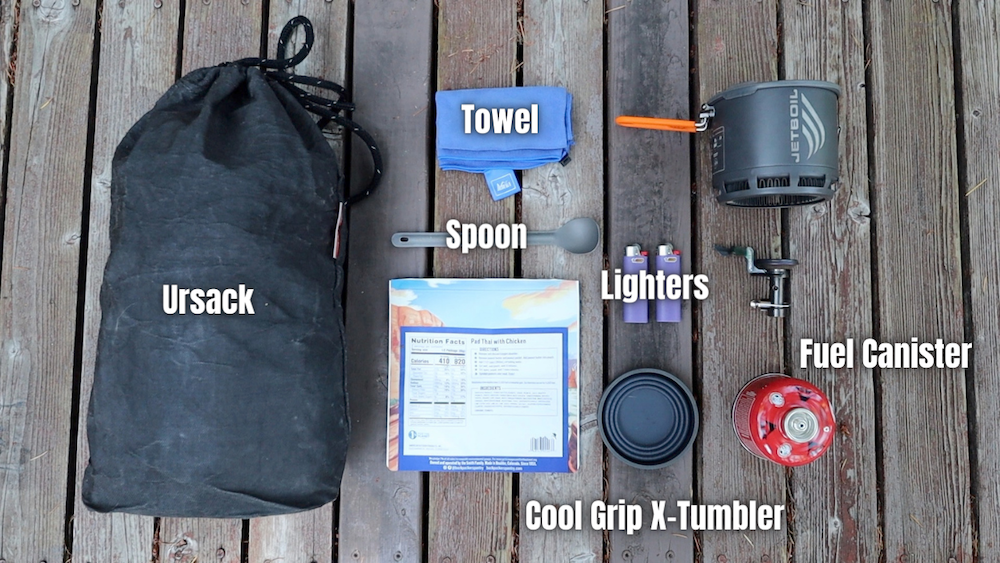
When it comes to my resupply strategy for my PCT hike this year, I’ve gotten a bunch of questions asking how I resupply my food and gear and the backpacking food I ate while out on trail.
So in this post, I’m going to share with you my PCT resupply strategy for my hike this year along with where I resupplied my food and gear, how often I resupplied, my favorite backpacking food and town food I ate along the way, the Cooking System I used for my hike and the backpacking gear I sent to myself while I was out on trail.
Maybe you’re in the process of planning your own long-distance backpacking trip and have questions about how to put together your own resupply strategy.
OR maybe you’re just curious how hikers get their food when their out hiking long-distance trails, want to know what backpacking food they eat while they’re out there, where they resupply their food and gear and how they send themselves stuff when out on trail.
Over the last few years, I’ve talked a lot about the backpacking food I’ve brought with me on my various long-distance backpacking trips, but I haven’t talked about how I resupply my food and gear when I’m out there.
Hopefully this post will help inspire you to start planning your next long-distance backpacking trip and give you a few ideas on how to put together your own resupply strategy.
So let’s talk about my PCT resupply strategy and the backpacking food I ate while hiking the PCT this year, starting with how I resupplied my food and gear.
How Did I Resupply My Food and Gear?
There are multiple ways a hiker can resupply themselves while out on trail. They can:
- Send a box to themselves via mail, like USPS or even UPS or FedEx, depending on where they want to pick up their box from.
- Hikers can resupply in town at grocery stores, general stores or even convenience stores.
- They can use a resupply coordination service
- A combination of all three
This year, I hiked 981 miles of the Pacific Crest Trail, heading southbound, starting from the Washington/Oregon border at the Eagle Creek Trailhead until I reached Tuolumne Meadows in Yosemite, where I got off trail for the year and headed into Mammoth Lakes.
My resupply strategy for my PCT hike this year included resupplying food in bigger towns, sending myself two boxes (1 to Timberline Lodge near Mount Hood and 1 to Crater Lake) and using the Backcountry Foodie’s Resupply Coordination Service.
Backcountry Foodie’s Resupply Coordination Service is a pay-as-you-go service, which allowed me to use the service as much or as little as I needed.
In addition to having the Backcountry Foodie as my personal shopper, chef, resupply support person and dietician, I also sent to her some of my gear, food I had prepared at home and supplies and toiletries I knew I’d need further down the trail.
As part of this service, she stored all of the items I sent to her prior to my hike. Then whenever I needed any of these items sent to me out on trail, I’d place an order with Backcountry Foodie who would then put together my customized box and send it to me out on trail whenever and wherever I needed it.
For my PCT hike this year, I ended up having TWO boxes sent to me using Backcountry Foodie’s Resupply Coordination Service:
The first box had 4 days’ worth of food and was originally sent to Seiad Valley. Since the town went under a Level 3 Evacuation Order this summer due to nearby wildfires, the box was sent back to Backcountry Foodie where she was able to send it to me further on down the trail.
Backcountry Foodie took care of all the rerouting, tracking and eventually re-sending of the box to me out on trail while I got to focus on my hike. This box was then sent to Sierra City for one of my resupply stops in Northern California.
My second Backcountry Foodie box was sent to me at Kennedy Meadows North. This box not only included a 6-day food resupply, but it also included special gear I’d need for the next section including:
- My Gore-Tex gaiters
- A new pair of Altra Lone Peak 7s
- My BV500 hard-sided bear canister
- A brand-new pair of Kahtoola Microspikes
Even though I only got to utilize Backcountry Foodie’s Resupply Coordination Service for two boxes out on trail this year, having her help while I was out there was such a stress relief, especially with the box that was sent to Seiad Valley that I didn’t get to pick up.
Not only did I NOT have to worry about trying to piece together a resupply with limited options in these two small towns, but I got to hand pick meals and snacks I was craving at the time and get the gear I needed to hike the next section with, sent to me without having to worry about trying to find someone at home to send these things to me. What a relief!
My PCT Resupply Strategy was Dependent on Four Things:
- The section of the trail I was hiking
- The number of days I planned on hiking that section
- How much food and gear I wanted to carry
- And what kind of backpacking food I wanted to eat
When planning my resupply strategy for upcoming sections, I’d use the FarOut Guide app along with onX Backcountry and my Garmin inReach Mini 2.
I’d start putting together my resupply for my upcoming town stop by creating a route on the FarOut Guide app to figure out what the mileage would be to get to the next town and the number of days it would take me to get there.
I’d also check the terrain for the upcoming section by using the elevation profile on FarOut.
I could then figure out how fast or slow I thought I’d hike each day and anticipate how many days it would take me to hike that section.
I’d then use the Town Guide and read the user comments on FarOut to see what resupply options were available in town and look for details like places to eat in town, availability of stores and restaurants, store hours, prices and the selection of food and snacks I could expect.
I’d also factor in any side or alternate trips I wanted to take in the section so I’d look at both the map on FarOut for anything on the PCT and onX Backcountry for anything off of the PCT.
Sometimes weather could slow me down when out on trail so I’d also check the current weather for my exact location to see if there were any storms or rain forecasted for the area I’d be hiking in.
Once I had all of this information, I’d put together my resupply strategy for the upcoming section. I’d make a guess on how long it would take me to get to the next town and decide how much food I would need to pack, based on how hungry I thought I’d might be.
For Example: If there were 75 miles to my next town stop and I planned on hiking 15 miles each day, I’d know that I’d need to carry 5 days’ worth of food for that section.
It’s important to figure this out while you’re out on trail and not BEFORE starting your hike because things constantly change while you’re out there. It’s hard to know where you’re going to be, when you’re going to be there and what you’ll want to eat when you’re out hiking, while you’re still at home planning your hike.
This is a HUGE reason why I don’t prepare and send myself a bunch of resupply boxes before I start a long-distance hike. Also, I know my food cravings will change while I’m out there, so I want to give myself the flexibility to be able to change up my trail menu, based on whatever I’m currently craving.
Where Did I Resupply My Food and Gear?
For my PCT hike this year, I started off with packing 4-days’ worth of food for the first 75 miles. Along the way, I resupplied my food and gear in 10 different towns including:
In Oregon:
- Timberline Lodge where a friend brought me a box
- Bend where I resupplied both food and gear in town
- Crater Lake where I sent myself a box
- Ashland where I resupplied in town
In California:
- I picked up a couple more meals and a few snacks in Dunsmuir
- Burney where I resupplied food in town
- Chester where I resupplied both food and gear while I was in town
- Quincy where I resupplied food in town
- Sierra City, I received my first Backcountry Foodie resupply with food and a few supplies
- South Lake Tahoe where I resupplied food in town
- Kennedy Meadows North, where I had my second Backcountry Foodie box sent to me that had both food and gear I needed for the upcoming section


When I would resupply in town, I would often get food from the local grocery store.
Sometimes in-between bigger towns, I’d stop for snacks in smaller, general stores like I did at Crater Lake, Shelter Cove and Kennedy Meadows North.
How Often Did I Resupply?
For the rest of the 900 miles of my hike, I sent myself four boxes (2 of those were from Backcountry Foodie utilizing her Resupply Coordination Service) and resupplied in 6 towns.
The average number of days between my resupply stops were about 4 days, but I’d sometimes have to carry up to 6- or 7-days’ worth of food in-between towns.
The Backpacking Food I Ate
The backpacking food I ate on trail would greatly depend on whatever I was craving at that time. My trail menu consisted of breakfast, lunch, dinner, several snacks throughout the day and electrolytes.
Breakfast
For breakfast, I would almost always have one of Backcountry Foodie’s Peanut Butter Power Shakes. I’d try to make these in town with what I could find in the grocery store or order them from Backcountry Foodie directly and have her send these to me out on trail.
I loved having shakes in the morning because for some reason, it’s hard for me to eat breakfast when out on trail, but it’s much easier to drink the calories. And what’s there not to love about a peanut butter shake in the morning?
For second breakfast, I’d often reach for a Munk Pack Protein Cookies or a Think! Bar for an extra protein punch in the morning.
Lunch
My go-to lunches out on trail this year were:
Sliced peppered salami, cheese and crackers or mini naan bread because this was a quick and easy meal that didn’t need water or fuel to prepare.
Backcountry Foodie’s Buffalo Chicken Pasta Salad. This recipe is a little involved to make and requires boiling water, but it’s so delicious and I’d add a chicken punch to it for more calories and protein.
I used Backcountry Foodie’s recipe to prepare a bunch of these at home and utilized the Backcountry Foodie Resupply Coordination Service to send them to me out on trail.
Peanut Butter Ramen Noodles with a chicken pouch was my midday power meal whenever I needed an extra boost during the day. I’d either have these for lunch or as a midday snack, depending on how hungry I was and how much extra energy I needed.
Dinner
For dinner, I’d always treat myself to a warm meal while at camp at the end of the day. Some of my favorite dinners this year were:
Homemade, Freeze-Dried Hamburger Pie
This is a family recipe I prepared at home and freeze dried before my hike. I started my hike with one of these meals, included some of them in my resupply boxes and sent them to Backcountry Foodie to include in future resupply boxes on down the trail.
My One-Pot Thanksgiving Dinner
Because this one is loaded with calories, is easy to shop for the ingredients in any grocery store and is easy to make out on trail. Just needs boiling water. Click HERE for the recipe.
Any of the Peak Refuel Backpacking Meals
My favorite Peak Refuel Meal is the Chicken Coconut Curry. I’d use these meals as a special treat and would typically only pack one per section since they were more expensive than food I could get in the grocery store.
Snacks
Snacks were life for me out on trail this year because I could eat them on the go while I was hiking and most of the time, I didn’t need to pull out my stove or need water to prepare them.
Some of my favorite snacks I enjoyed eating out on trail this year included:
- Pickles in single serving packs
- Gummi bears or gummi peaches
- Single serving packets of Almond butter
- Various nuts
- Dried fruit like sweetened dried orange slices
- And chili spiced mango from Trader Joe’s
- Oreo Thins
- Freeze dried Pizza Rolls I prepared at home, which were surprisingly delicious!
- Various cookies like lemon wafer cookies and these thin chocolate chip cookies
- Snickers
- Trader Joe’s Milk Chocolate Truffle Bars
- Beef sticks
- Harvest Snaps Baked Green Peas
- I always packed out a bag of potato chips from every town stop
Electrolytes
My electrolyte of choice this year out on trail was Blue Powdered Gatorade. It might not be the healthiest option, but it’s one of the tastiest in my opinion. Before my hike this year, I bought a 76-ounce container on Amazon and packaged it into smaller serving sizes using Ziplock bags to take with me out on trail.
Town Food
Town food was always one of the first things I’d look forward to whenever coming into a town. It was ALWAYS a treat to be able to eat food that wasn’t in my food bag or needed hot water to prepare.
Some of my favorite town food this year out on the PCT were:
- Packing out a turkey sandwich from the deli
- Cheeseburgers
- BLTs with onion rings
- Tasty chocolate desserts with ice cream
- Pasta
- Soft serve
- A McDonald’s Big Mac and fries
- A proper diner breakfast with eggs, bacon, hash browns and pancakes
- Pizza
- French Dips
- A big bowl of ramen – ramen is something I never got sick of out on trail this year, even in town
- Normally an iced cold root beer, but for some reason, this year I craved an iced cold coke a lot more
Pro Tip #1: Store Day One (or your day of) Food Bag with all of your food for the day in the back mesh pocket on your pack so it’s easily accessible throughout the day. This way, you don’t have to get into your pack to get your food out AND you’re more likely to eat all of the food you had planned out for the day instead of carrying it.
Pro Tip #2: Only pack the food you love because you’re more likely to eat it.
My Cooking System
For my cooking system, I used my JetBoil Stash Stove to boil water for my meals at my camp, my Sea to Summit Long Spoon, a Sea to Summit Cool Grip X-Tumbler to measure water and have a cup out on trail, my REI small multi towel, a small fuel canister, 2 Bic lighters and stored all of my food in a 10-liter AllMitey Ursack.

I used a gallon sized Ziplock bag to keep all of my “day of” food in and stored this in the back mesh pocket of my pack for easy access throughout the day.
To help rehydrate my meals faster at camp, I used a leftover freeze-dried backpacking meal bag instead of my slightly bulky Backcountry Food Cozy that I love using on my shorter trips because it’s light and folds down and fits much easier into my food bag.
At Kennedy Meadows North, I switched out my Ursack for the BV500 hard-sided bear canister since bear canisters are required through the Sierra section of the PCT.
Backpacking Gear I Sent To Myself
Even though I started my PCT hike this year with all the backpacking gear I needed, there were a few times during my hike when I had to send myself, replace or switch out backpacking gear and supplies I was using.
144 miles into my hike this year, I went into Bend, Oregon and had to get a new pair of Altra Lone Peak 7s, a new fuel canister, travel toothbrush and toothpaste and exchanged my tent for a new one since the tentpoles had cracked and broke during the previous section.
I also decided to purchase a pair of camp shoes, the OOFOS OOahh Slide Sandals to help make my feet more comfortable during breaks and while at camp.
168 miles later when I reached Crater Lake, I picked up a new fuel canister and was able to replenish my resupply of Portawipes that were in the resupply box I had sent to myself.
In Chester, California, I picked up a new fuel canister, was able to send my tent back to REI and get a new one sent to me from REI via UPS since the tentpoles had cracked and broke AGAIN and picked up another travel toothbrush and toothpaste from the local grocery store.
In my resupply box sent to me in Sierra City through using Backcountry Foodie’s Resupply Coordination Service, I was able to get another resupply of Portawipes along with a full food resupply for the next section.
Then in Kennedy Meadows North, I received my second resupply box sent to me through using Backcountry Foodie’s Resupply Coordination Service, which had my own gear I needed for the upcoming section of trail including:
- A pair of Gore-Tex gaiters
- A new pair of Altra Lone Peak 7s
- My BV500 Hard-sided bear canister and then sent home my Ursack
- A pair of Fayettechill Sage pants
- And a brand new pair of Kahtoola Microspikes that Backcountry Foodie had ordered for me and included in my box
Hopefully I was able to answer the questions you had about how I put together my PCT resupply strategy, the backpacking food I ate while hiking the PCT this year and how I resupplied my food and gear while I was out on trail.
If you still have questions about putting together a resupply strategy for your own upcoming backpacking trip, put them down in the comments below.
Interested in learning more about Backcountry Foodie’s Resupply Coordination Service? Want to use Backcountry Foodie to get new backpacking meal recipes and help you meal plan for your next overnight backpacking trip?
CLICK HERE to get 20% off your Backcountry Foodie membership and use coupon code “HUNGRYHIKER20”
Disclaimer: The-Hungry-Hiker.com is a participant in the Amazon Affiliate Links and AvantlInks Program, affiliate advertising programs designed to provide a means for sites to earn advertising fees by advertising and linking to Amazon.com and other affiliated sites at no cost to you. Please note, I only link to products and services I personally use and trust.

Hi Kathleen – In my research I noticed that Backcounty Foodie’s Resupply Service is closing shop. Do you have any other resupply services that you would recommend?
Kind regards!
Hey there! Other than Backcountry Foodie’s Resupply Service, I don’t have any experience with any other resupply services out there. Sorry!